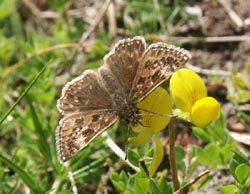 |
Erynnis tages © photo: Allen Beechey |
In 2007 the Dingy Skipper became a UK Priority Species. The Dingy Skipper had been identified in the Thames Regional Action Plan as having Medium Priority status but new knowledge of its distribution and rates of decline thanks to the Millennium Atlas demonstrated why species should be given such urgent higher priority.
A copy of the Species Action Plan can be downloaded here.
Details of the Eastern Region Dingy Skipper Awareness Campaign here
Dingy Skipper is a small brown and greyish butterfly. The flight period is usually early May until the end of June, but can be earlier depending on the weather and I have recorded it in early July. It is an extremely fast flyer and difficult to follow. The best time to observe them I have found, is when they first hatch and take their first flight or if you disturb them when the weather is not ideal. Evenings and early mornings, are another time to seek them out on dead flower heads, while they roost. They can however be difficult to see because they are well camouflaged.
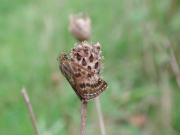 |
© photo: Andrew Middleton |
The Burnet Companion moth can be confused for Dingy Skipper as they fly at the same time. After watching both for some time, you get to know the difference in the way they fly and settle, but still check!
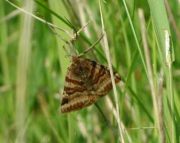 |
euclidea glyphica © photo: Nick Sampford |
The eggs are laid singly on new leaves of largish plants, usually in sheltered postions. When laid they are green at first, but then changing to a more noticeable orange after about five days.
Common Bird's-foot Trefoil (lotus corniculatus) is the main food plant. Horseshoe Vetch (hippocrepis comosa) and Greater Bird's-foot Trefoil (lotus pedunculatus) are also used.
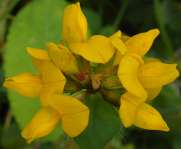 |
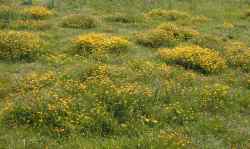 |
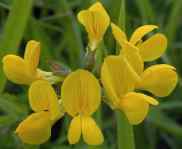 |
lotus pedunculatus © photo: Malcolm Storey BioImages - Virtual Field-Guide (UK) |
lotus corniculatus © photo: Malcolm Storey BioImages - Virtual Field-Guide (UK) |
hippocrepis comosa © photo: Malcolm Storey BioImages - Virtual Field-Guide (UK) |
Larvae hatch after about 14 days and immediately spin leaves together to form a tent in which it lives. Fully grown by August, it hibernates as a caterpillar throughout the winter, before pupating the following spring. They start to emerge in early May
© photo: Gavin Vicary |
| Site | Tetrad | Last record | Site | Tetrad | Last record |
| Aldbury Nowers | SP9412 | 2010 | Hexton Chalk Pit | TL1028 | 2010 |
| Tring Park | SP9210 | 2010 | Wood Lane area, Pirton | TL1028 | 2010 |
| Telegraph Hill | TL1028 | 2010 | Hoo Bit (adjacent to Telegraph Hill) | TL1129 | 2010 |
Based on information available in the Branch Annual Reports
| Flight Dates | Year |
| 28 April - 16 June | 2010 |
| 29 April - 01 June | 2009 |
| 08 May - 18 June | 2008 |
| 24 April - 10 June | 2007 |
| 11 May - 24 June | 2006 |
| 03 May - 17 June | 2005 |
| 15 May - 19 June | 2004 |
| 11 May - 15 June | 2003 |
| 11 May - 20 June | 2002 |
| 29 May - 14 June | 2001 |
| 07 May - 17 June | 2000 |
| 16 May - 26 June | 1999 |
| 18 May - 24 June | 1998 |
| 30 April - 07 June | 1997 |
| 02 June - 17 June | 1996 |
| SYMBOL | DATE | REFERENCE SOURCE |
 | 1996-2004 | Indicates records taken from the Herts & Middx Butterfly Report for 1999 - John B. Murray & Rob Souter and Herts & Middx Butterfly Report for 2003 - John B. Murray & Andrew Wood |
 | 1970-1987 | Indicates records taken from Butterflies of Hertfordshire -
Brian Sawford 1987 or The Butterflies of the London Area - Colin Plant 1987 |
| O | pre 1970 | Sites where Dingy Skipper were found pre 1970 records taken from The Butterflies of Hertfordshire - Brian Sawford 1987 |
Andrew Palmer and Brian Jessop
Any sightings should be recorded and sent to J.B.Murray@open.ac.uk in the usual way but we would also be glad to hear about them during the flight period so please also contact Liz Goodyear through the website